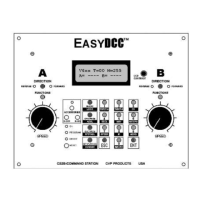27
Wireless Receiver Placement Considerations
Every layout environment is different. Therefore we recommend an extended period of trial and
error receiver placement.
Keep all material and objects away from the receiver's antenna, especially metallic objects.
Human bodies will affect reception patterns and absorb radio energy. Consider
experimenting with receiver location when the normal number of operators are present.
Higher is generally better. Rafter installations, especially in basements, seem to be better than
the floor. But we've also had a report that lower is better; you should always try both.
Keep it away from areas of high concentrations of throttles. Pick a spot away from an area
that will have a heavy concentration of wireless throttles. A nearby wireless throttle can swamp
out the receiver preventing a distant throttle from being heard.
Use the lowest throttle power setting possible. For T5000E throttles that tend to stay in one
area and that near the receiver, use a lower power level.
Always test multiple locations. To test a location, temporarily set the receiver the test location.
Then walk the layout with a SINGLE throttle that is set for a decoder with a good loud horn or
whistle. Push the F2 key to sound the horn. If you can hear the horn responding to F2 commands
no matter where you are on the layout, you've found a fairly good spot for the receiver.
A new location can be as close as 1 foot. In many cases a move of less than 1 foot in any
direction, can make a dramatic difference in reception. After a weak area has been identified,
move the receiver towards the weaker area. If you find a chronic weak area, consider adding a
second receiver to provide additional coverage in the weak area.
AC lamp dimmers can sometimes jam a receiver. These devices emit a broad spectrum of
interfering radio signals and can sometimes jam the receiver. If you have a lighting system like
this, consider not using it or equipping it with UL approved line filters.
Keep the receiver antenna away from fluorescent lights.
Train your operators to recognize when the receiver has lost contact or “dropped” the wireless
throttle. The command station can not tell the difference between a “dropped wireless throttle” or
a wireless throttle that has been turned off. The locomotive either keeps moving or it never starts
moving because the receiver can not "hear" the wireless throttle. This can cause some interesting
problems if your operators are not trained. Here's an example:
Assume the operator has just stopped the train for a red signal. The signal clears and
the operator sets the speed control to the 11:00 position but the train doesn't move.
What do 99.9% of the people do at this point? That's right - they turn the speed
control higher! Wrong thing to do! The moment they shift their physical position a
few inches, the receiver will pick up their signal, and the train roars off at high speed!
A trained operator leaves the speed control alone and just moves his body position
by a foot or so. In almost all cases, the receiver will see the signal. Just like your cell
phone, if you are experiencing a large number of dropped commands from wireless
throttles, you should add additional wireless receivers to improve reception.
Don’t use surplus power supplies, especially the high-tech switching supplies are appearing on
many railroads. These supplies tend to be very inexpensive for the amount of power they
provide. However, these surplus supplies also emit a broad spectrum of interference and can
sometimes jam one or more of the wireless throttle's frequencies. Try turning off the power
supply to check if it is the cause of interference. If it is, the power supply should be replaced.
Beware of other non-railroad wireless equipment that could jam a receiver. The EasyDCC
throttles and receivers operate in an unlicenced band shared by many other wireless systems.
These systems can and do create jamming interference which can make some frequencies
unusable. Examples include wireless devices attached to computers, TV remote controls,
cordless telephones, wireless alarm systems, baby monitors, personal communication devices,
lawn sprinkler and outdoor lighting controllers, cordless light switches, toys/games, wireless
headphones and speakers. The list grows longer every Christmas season.

